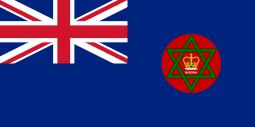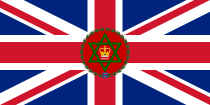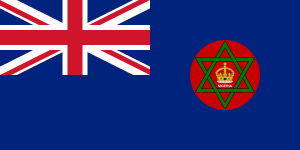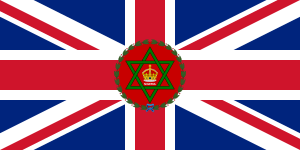Flag of Nigeria (1914–1960) facts for kids
 |
|
| Use | State flag, civil and state ensign |
|---|---|
| Adopted | 1952 (earlier version in 1914) |
| Relinquished | 1960 |
| Design | Blue ensign with a green six-pointed star described as the Seal of Solomon, surrounding St Edward's Crown with the white word "Nigeria" under it on a red disc |

Variant flag of Colony and Protectorate of Nigeria
|
|
| Name | Flag of the governor-general of Nigeria |
| Adopted | 1952 (earlier version in 1914) |
| Relinquished | 1960 |
| Design | A Union Flag defaced with the coat of arms. |
Imagine a flag that told a story of a country's past! The Flag of Nigeria used from 1914 to 1960 was a special British flag called a blue ensign. It had a cool design: a green six-pointed star, sometimes called the Seal of Solomon. This star was placed around a crown, which changed from a Tudor Crown to a St Edward's Crown in 1953. Below the crown, the word "Nigeria" was written in white on a red circle.
This flag was adopted when the British joined the Southern and Northern parts of Nigeria together. This new area was called the Colony and Protectorate of Nigeria.
Contents
What Was the Flag of Colonial Nigeria?
The flag of Nigeria during its time as a British colony was a type of flag known as a blue ensign. This means it had a blue background with the Union Flag (the flag of the United Kingdom) in the top left corner. In the middle-right part of the flag, it featured a special symbol.
This symbol included a green six-pointed star, known as the Seal of Solomon. It surrounded a crown, which was a symbol of the British monarchy. The word "Nigeria" was written below the crown. This flag represented Nigeria during a significant period of its history.
The Story Behind the Flag
The colonial flag of Nigeria was first used in 1914. This happened after the British brought together the Southern and Northern parts of Nigeria. This joining of territories was called an amalgamation. The symbol on this flag was also used on the flag of the person in charge, known as the governor-general of Nigeria.
Why the Green Star?
In 1940, a former governor-general named Frederick Lugard explained the meaning of the green six-pointed star. He said the design, often called "Solomon's Seal," was found on a beautiful brass and copper jug. This jug was taken when a powerful leader in Northern Nigeria was defeated.
Lugard thought this symbol would be perfect for Northern Nigeria. When the North and South joined, he suggested it become the symbol for all of united Nigeria.
A New Flag for a New Nation
Even with its unique design, the colonial flag was not loved by everyone. As Nigeria prepared to become an independent country, people wanted a new flag. In 1959, a competition was held to design a new national flag.
A young student named Taiwo Akinkunmi designed the winning flag. This new flag of Nigeria replaced the old blue ensign in 1960. This marked a fresh start for Nigeria as an independent nation.
See also



